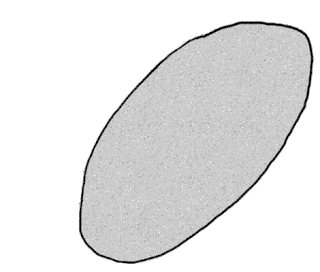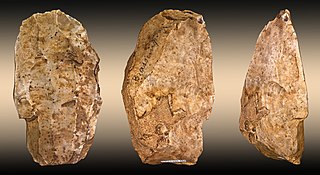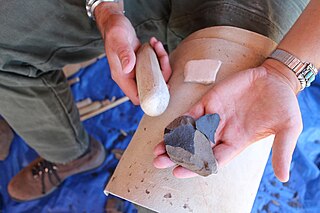
In archaeology, a hammerstone is a hard cobble used to strike off lithic flakes from a lump of tool stone during the process of lithic reduction. The hammerstone is a rather universal stone tool which appeared early in most regions of the world including Europe, India and North America. This technology was of major importance to prehistoric cultures before the age of metalworking.

In archaeology, in particular of the Stone Age, lithic reduction is the process of fashioning stones or rocks from their natural state into tools or weapons by removing some parts. It has been intensely studied and many archaeological industries are identified almost entirely by the lithic analysis of the precise style of their tools and the chaîne opératoire of the reduction techniques they used.

In archaeology, a lithic flake is a "portion of rock removed from an objective piece by percussion or pressure," and may also be referred to as simply a flake, or collectively as debitage. The objective piece, or the rock being reduced by the removal of flakes, is known as a core. Once the proper tool stone has been selected, a percussor or pressure flaker is used to direct a sharp blow, or apply sufficient force, respectively, to the surface of the stone, often on the edge of the piece. The energy of this blow propagates through the material, often producing a Hertzian cone of force which causes the rock to fracture in a controllable fashion. Since cores are often struck on an edge with a suitable angle (<90°) for flake propagation, the result is that only a portion of the Hertzian cone is created. The process continues as the flintknapper detaches the desired number of flakes from the core, which is marked with the negative scars of these removals. The surface area of the core which received the blows necessary for detaching the flakes is referred to as the striking platform.
In lithic analysis, a subdivision of archaeology, a bulb of applied force is a defining characteristic of a lithic flake. Bulb of applied force was first correctly described by Sir John Evans, the cofounder of prehistoric archeology. However, bulb of percussion was coined scientifically by W.J. Sollas. When a flake is detached from its parent core, a portion of the Hertzian cone of force caused by the detachment blow is detached with it, leaving a distinctive bulb on the flake and a corresponding flake scar on the core. In the case of a unidirectional core, the bulb of applied force is produced by an initiated crack formed at the point of contact, which begins producing the Hertzian cone. The outward pressure increases causing the crack to curve away from the core and the bulb formation. The bulb of applied force forms below the striking platform as a slight bulge. If the flake is completely crushed the bulb will not be visible. Bulbs of applied force may be distinctive, moderate, or diffuse, depending upon the force of the blow used to detach the flake, and upon the type of material used as a fabricator. The bulb of applied force can indicate the mass or density of the tool used in the application of the force. The bulb may also be an indication of the angle of the force. This information is helpful to archaeologists in understanding and recreating the process of flintknapping. Generally, the harder the material used as a fabricator, the more distinctive the bulb of applied force. Soft hammer percussion has a low diffuse bulb while hard hammer percussion usually leaves a more distinct and noticeable bulb of applied force. Pressure flake also allowed for diffuse bulbs. The bulb of percussion of a flake or blade is convex and the core has a corresponding concave bulb. The concave bulb on the core is known as the negative bulb of percussion. Bulbs of applied force are not usually present if the flake has been struck off naturally. This allows archaeologists to identify and distinguish natural breakage from human artistry. The three main bulb types are flat or nondescript, normal, and pronounced. A flat or nondescript bulb is poorly defined and does not rise up on the ventral surface. A normal bulb on the ventral side has average height and well-defined. A pronounced bulb rises up on ventral side and is very large.

In archaeology, a lithic core is a distinctive artifact that results from the practice of lithic reduction. In this sense, a core is the scarred nucleus resulting from the detachment of one or more flakes from a lump of source material or tool stone, usually by using a hard hammer precursor such as a hammerstone. The core is marked with the positive scars of these flakes. The surface area of the core which received the blows necessary for detaching the flakes is referred to as the striking platform. The core may be discarded or shaped further into a core tool, such as can be seen in some types of handaxe.
In archaeology, a tool stone is a type of stone that is used to manufacture stone tools, or stones used as the raw material for tools.
In archaeology, a prismatic blade is a long, narrow, specialized stone flake tool with a sharp edge, like a small razor blade. Prismatic blades are flaked from stone cores through pressure flaking or direct percussion. This process results in a very standardized finished tool and waste assemblage. The most famous and most prevalent prismatic blade material is obsidian, as obsidian use was widespread in Mesoamerica, though chert, flint, and chalcedony blades are not uncommon. The term is generally restricted to Mesoamerican archaeology, although some examples are found in the Old World, for example in a Minoan grave in Crete.
A stone tool is, in the most general sense, any tool made either partially or entirely out of stone. Although stone tool-dependent societies and cultures still exist today, most stone tools are associated with prehistoric cultures that have become extinct. Archaeologists often study such prehistoric societies, and refer to the study of stone tools as lithic analysis. Ethnoarchaeology has been a valuable research field in order to further the understanding and cultural implications of stone tool use and manufacture.

Knapping is the shaping of flint, chert, obsidian, or other conchoidal fracturing stone through the process of lithic reduction to manufacture stone tools, strikers for flintlock firearms, or to produce flat-faced stones for building or facing walls, and flushwork decoration. The original Germanic term knopp meant to strike, shape, or work, so it could theoretically have referred equally well to making statues or dice. Modern usage is more specific, referring almost exclusively to the hand-tool pressure-flaking process pictured. It is distinguished from the more general verb "chip" and is different from "carve", and "cleave".
In archaeology, lithic analysis is the analysis of stone tools and other chipped stone artifacts using basic scientific techniques. At its most basic level, lithic analyses involve an analysis of the artifact's Morphology (archaeology), the measurement of various physical attributes, and examining other visible features.

A hand axe is a prehistoric stone tool with two faces that is the longest-used tool in human history, yet there is no academic consensus on what they were used for. It is made from stone, usually flint or chert that has been "reduced" and shaped from a larger piece by knapping, or hitting against another stone. They are characteristic of the lower Acheulean and middle Palaeolithic (Mousterian) periods, roughly 1.6 million years ago to about 100,000 years ago, and used by Homo erectus and other early humans, but rarely by Homo sapiens.

In the field of lithic reduction, a burin is a type of handheld lithic flake with a chisel-like edge which prehistoric humans used for engraving or for carving wood or bone.

Clovis points are the characteristically fluted projectile points associated with the New World Clovis culture, a prehistoric Paleo-American culture. They are present in dense concentrations across much of North America and they are largely restricted to the north of South America. There are slight differences in points found in the Eastern United States bringing them to sometimes be called "Clovis-like". Clovis points date to the Early Paleoindian period, with all known points dating from roughly 13,400–12,700 years ago. As an example, Clovis remains at the Murry Springs Site date to around 12,900 calendar years ago. Clovis fluted points are named after the city of Clovis, New Mexico, where examples were first found in 1929 by Ridgely Whiteman.

In archaeology, a blade is a type of stone tool created by striking a long narrow flake from a stone core. This process of reducing the stone and producing the blades is called lithic reduction. Archaeologists use this process of flintknapping to analyze blades and observe their technological uses for historical purposes.

The Levallois technique is a name given by archaeologists to a distinctive type of stone knapping developed around 250,000 to 300,000 years ago during the Middle Palaeolithic period. It is part of the Mousterian stone tool industry, and was used by the Neanderthals in Europe and by modern humans in other regions such as the Levant.
In lithic analysis in archaeology the cortex is the outer layer of rock formed on the exterior of raw materials by chemical and mechanical weathering processes. It is often recorded on the dorsal surface of flakes using a three class system: primary, secondary, and tertiary. The amount of cortex present on artifacts in an archaeological assemblage may indicate the extent of lithic reduction that has occurred. Primary, secondary, and tertiary designations for flakes are generally determined by relative amounts of cortex presented on the dorsal surface. Some archaeologists classify flakes with no cortex as tertiary, flakes with some cortex as secondary, and flakes with all cortex as primary, whereas others make distinctions at every third or half of the dorsal surface covered. Differences in how archaeologists classify the amount of cortex and the results of experimental archaeological tests demonstrating moderate correlation between amount of cortex and stage of reduction, have limited the validity of assumptions based on amount of cortex solely.
Retouch is the act of producing scars on a stone flake after the ventral surface has been created. It can be done to the edge of an implement in order to make it into a functional tool, or to reshape a used tool. Retouch can be a strategy to reuse an existing lithic artifact and enable people to transform one tool into another tool. Depending on the form of classification that one uses, it may be argued that retouch can also be conducted on a core-tool, if such a category exists, such as a hand-axe.
In archaeology, lithic technology includes a broad array of techniques used to produce usable tools from various types of stone. The earliest stone tools to date have been found at the site of Lomekwi 3 (LOM3) in Kenya and they have been dated to around 3.3 million years ago. The archaeological record of lithic technology is divided into three major time periods: the Paleolithic, Mesolithic, and Neolithic. Not all cultures in all parts of the world exhibit the same pattern of lithic technological development, and stone tool technology continues to be used to this day, but these three time periods represent the span of the archaeological record when lithic technology was paramount. By analysing modern stone tool usage within an ethnoarchaeological context, insight into the breadth of factors influencing lithic technologies in general may be studied. See: Stone tool. For example, for the Gamo of Southern Ethiopia, political, environmental, and social factors influence the patterns of technology variation in different subgroups of the Gamo culture; through understanding the relationship between these different factors in a modern context, archaeologists can better understand the ways that these factors could have shaped the technological variation that is present in the archaeological record.

In archaeology, a flake tool is a type of stone tool that was used during the Stone Age that was created by striking a flake from a prepared stone core. People during prehistoric times often preferred these flake tools as compared to other tools because these tools were often easily made, could be made to be extremely sharp & could easily be repaired. Flake tools could be sharpened by retouch to create scrapers or burins. These tools were either made by flaking off small particles of flint or by breaking off a large piece and using that as a tool itself. These tools were able to be made by this "chipping" away effect due to the natural characteristic of stone. Stone is able to break apart when struck near the edge. Flake tools are created through flint knapping, a process of producing stone tools using lithic reduction.

In archaeology, debitage is all the material produced during the process of lithic reduction – the production of stone tools and weapons by knapping stone. This assemblage may include the different kinds of lithic flakes and lithic blades, but most often refers to the shatter and production debris, and production rejects.